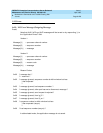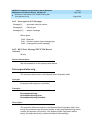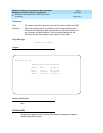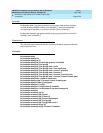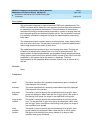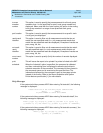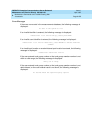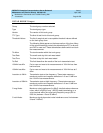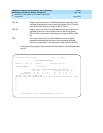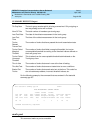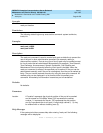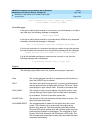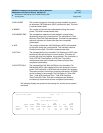
DEFINITY Enterprise Communications Server Release 5
Maintenance and Test for R5vs/si
555-230-123
Issue 1
April 1997
Maintenance Commands and Trouble-Clearing Aids
Page 8-236list testcalls
8
DETAIL REPORT Output
Group The trunk group number selected.
Type The trunk group type.
Vendor The vendor of this trunk group.
TTL Type The kind of test line for this trunk group.
Threshold Values The list of marginal and unacceptable threshold values defined
on the trunk group form.
The following fields appear on the lower section of the form. Many
of the column headings contain the abbreviations "FE" for far end
and "NE" for near end. These abbreviations define which end took
the measurements.
Trk Mem The trunk member within the trunk group.
Test Date The month and day this trunk was tested.
Test Time The time of day this trunk was tested.
Tst Rslt This field describes the results of the trunk transmission test.
1004Hz-loss Min Far-to-near and near-to-far measurements of 1004-Hz loss from
low-level tone.
1004Hz-loss Max Far-to-near and near-to-far measurements of 1004-Hz loss at 0
dBm.
Loss dev at 404Hz Transmission tests at low frequency. These tests measure a
maximum positive and negative deviation of +9 and -9 dB from
the 1004-Hz loss measurements.
Loss dev at 2804Hz Transmission tests at high frequency. These tests measure a
maximum positive and negative deviation of +9 and -9 dB from
the 1004-Hz loss measurements.
C-msg Noise Maximum noise interference (in dBrnC: decibels above reference
noise, which is B(EQ)10 sup -12E(EQ) watts) terminating on a
voice terminal within the voice-band frequency range (500 to
2500 Hz) between 15 and 55 dBrnC.
C-ntch Noise Maximum signal-dependent noise interference on a line between
34 and 74 dBrnC.




